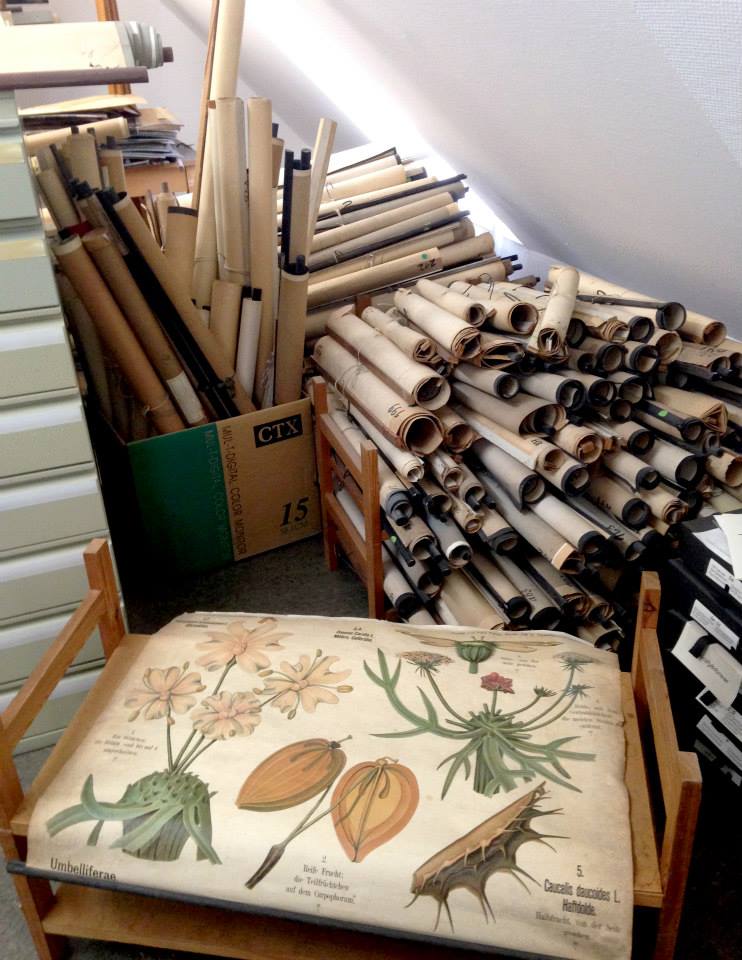(above) Unrolling & organizing charts in the attic archives at Berlin Botanical Garden & Library was a thrilling and dusty task.
The Botanical Wallchart: Art from the Golden Age of Scientific Discovery (London: Ilex); Botanical Art from the Golden Age of Scientific Discovery (Chicago: University of Chicago Press) 2016; 224p, 300 color plates.
This book documents an extraordinary convergence of disciplines that flourished in the late-nineteenth and early-twentieth centuries. Europe was enjoying a golden age of scientific discovery; naturalists were exploring the globe, and there was a clamoring for knowledge of the natural world. A pedagogical curiosity was no longer limited to elite salons and research; education was now considered a right afforded to all, in classrooms across the globe. And thus the botanical wall chart was born: a synthesis of art, science, and education.
The book’s chapters are organized by plant family, allowing readers to compare how illustrators from different countries and teaching backgrounds would represent the same species or family, and to learn about basic taxonomy (a summary of the family’s characteristics is included at the beginning of each chapter). In most cases, nineteenth-century botanists grouped species according to a classification system that persists today. In other cases, a species has since been renamed or reclassified—taxonomy is a subject that has long vexed botanists, striving to categorize plant species into groups that reflect their behaviors and evolution. Although Linneaus developed a useful framework of binomial nomenclature, it was only a beginning. Botanists today are still reclassifying and weighing morphological features. Just as species evolve, so does science.
Purchase: Amazon UK / Amazon US
Press
“This beautifully illustrated oversized book gives the humble wall chart its due, reproducing more than two hundred of them in dazzling full color.” — University of Chicago Press
“More than just a simple collection of wall charts, Laurent explicitly recognizes the value that they hold to explore complex relationships between plants and how people view them. This is a fabulous book. . . . Go out and buy a copy—you will not be disappointed.” —Economic Botany
“This collection – trawled from many countries in mainland Europe – is both reference book and visual treat. True to the educational ethos behind the wall charts, Laurent comments on each, including botanical notes that will help the reader garner a more intimate knowledge of the workings of their plants. Laurent also explains the context behind the production of each chart and includes a useful glossary outlining some of the less familiar botanical terminology used in the book.” —The English Garden
"Laurent has curated an exquisite collection of historic botanical art. This book is a treat for those who enjoy reading about botany, the history of science, or botanical illustrations." —New York Botanical Garden
Best Science & Nature Books of 2016, Book Scrolling
Top 10 Best Popular Science Books of 2016, New York Botanical Garden
Town & Country magazine, Editor’s Choice, Your Next Read, November 2016
Sunday Telegraph, Holiday Gift Guide, December 2016
ARTNews, “Flower Power: On Vegetation and Verdure in Art, December 2017
Personal essay about the book in Undark magazine, published at MIT’s Knight School of Journalism
“This spectacular work should be in every primary and secondary school and higher … the very art and science presented in this book was once used in the classroom to teach about the great age of discovery from all over the world … a two-page spread showing Dionaea muscipula (Venus flytrap) and Drosera rotundifolia (common sundew) is mesmerizing.”— Barney Lipscomb, Botanical Research Institute of Texas, Fort Worth, Texas, U.S.A.” Journal of the Botanical Research Institute of Texas
“In Botanical Art from the Golden Age of Scientific Discovery, the reader is introduced to the beautiful wall charts [that were] once used around the world to explain plant structure, form, and classification … re-created in large format, stunning color, and are arranged according to plant families. Each family is described and followed by representative charts. Lively captions give further information about the plants, the scientists, and the artists. The book’s seriousness is evident in the glossary. This title will serve well in an introductory botany course. Those interested in pedagogy, plants, and art will find pleasure and inspiration in this book.”— D. H. Pfister, Harvard University, Organismic and Evolutionary Biology
“For a scientific understanding of how plants work, there is no better teacher than a beautiful drawing.” — ‘The botanical writing is on the wall’, Sunday Telegraph, Bunny Guinness, October 28, 2016
“The author investigates an era when art, science and education met as equal partners to disseminate new botanical knowledge worldwide. This superb selection, mainly from the Continent, where most publishers were based, reflects a surprising diversity of styles. Loosely painterly or starkly diagrammatic, the charts juxtapose enlarged microscopic cross-sections with hyper-realistic plant portraits. The description includes each chart’s key elements and their botanical functions, often discussing and comparing why and how certain parts were depicted. These beautiful teaching aids that inspired generations of botanists are presented here as much for their undoubted artistic and historical interest as their scientific worth.” — The Garden, magazine of the Royal Horticultural Society, February 2017



